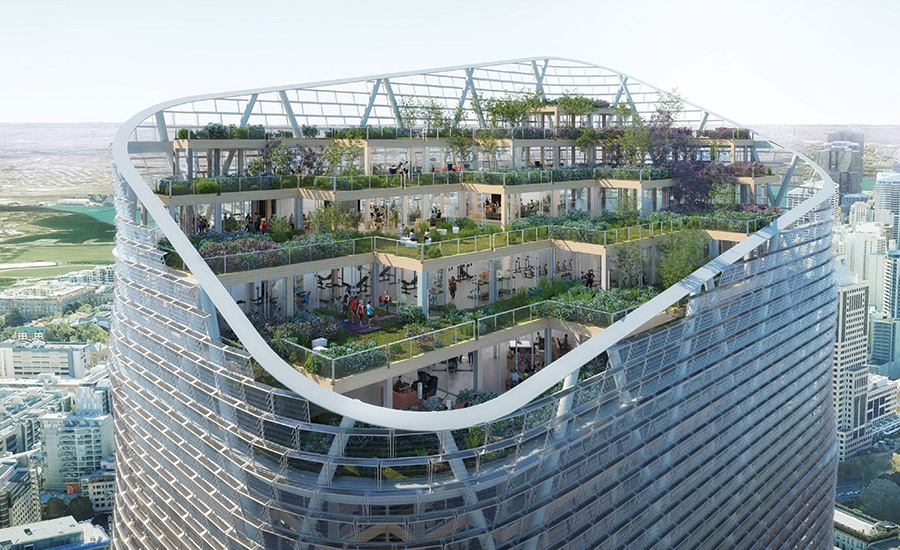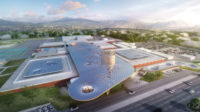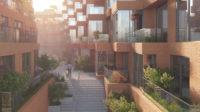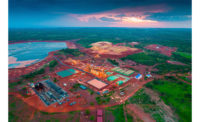On his first day in the Oval Office, President Biden signed an executive order recommitting the U.S. to the Paris Agreement. With new targets set to curb carbon emissions and build a greener, more resilient future, design firms and contractors are now tasked with helping owners reshape what it means to be green in the age of COVID-19.
Revenue numbers for this year’s Top 100 Green Design Firms and Contractors show signs of a market in transition. Total design revenue is $6.41 billion, a 12% drop from last year’s $7.28 billion. Contracting revenue is also down to $69.85 billion from $72.71 billion last year, a 3.9% drop.
Despite these dips, design firms and contractors say owners now more than ever want projects to incorporate green building standards, such as LEED, Envision and Parksmart, to reduce outside environmental footprints. Other standards, such as improving the health and well-being of building occupants, can add an additional shade of green to what is built.
“The pandemic has not fundamentally changed how our clients view sustainable buildings,” says Eric Sheffer, principal at Nashville-based SSR (Smith Seckman Reid). “But it has expanded emphasis on health, wellness and indoor environmental quality.”
Related Links
ENR 2021 Top 100 Green Building Contractors
ENR 2021 Top 100 Green Buildings Design Firms
View complete 2021 list, with full market analysis
(Subscription Required)
Building to Standards
Indoor healthy building standards such as WELL Building, Fitwel and Living Building Challenge are “all gaining significant traction in the construction design market,” Sheffer says, and SSR is actively “advocating to our clients to pursue factors which positively affect health and wellness in their designs.”
But rather than solely focusing on achieving a particular sustainability certification or healthy building rating, green design firms and contractors are finding that owners are hoping to build resiliency from the outside in. Such considerations include environmental risks such as wildfires and floods and social concerns such as pollution, public health and carbon footprint.
#6
STANTEC, INC. is the designer for the new California Military Department HQ. The project aims for net-zero and LEED Gold.
“The focus on health and wellness has intensified significantly as a result of the COVID-19 pandemic, and we are seeing a shift in responsibility for driving these improvements,” says Gunnar Hubbard, principal and sustainability practice leader at Thornton Tomasetti. “Previously tenants took the lead when it came to greening their spaces, but now building owners, especially in the office sector, are faced with a historic reset in the way tenants use their space.”
More owners are finding that they need to show what they are doing to promote health and wellness to attract and retain tenants, says Hubbard. To do this, many are opting to pursue the International WELL Building Institute’s WELL Health-Safety rating to help tenants feel more comfortable as they return to their buildings.
“The emergence of WELL standards reflects a growing focus on the health and wellness of building occupants and how they use the space in addition to operational performance and energy conservation,” says Hubbard. While many clients are building to these standards, not all are seeking to certify their projects.
“Our clients are increasingly trying to anticipate both natural and human-made threats to their properties and are more actively planning to meet the challenges of climate change,” says Hubbard. In addition to operational carbon emissions, “We are also seeing a greater focus on reducing embodied carbon, the greenhouse gas emissions arising from the manufacturing, transportation, installation, maintenance and disposal of building materials.”
Planning for Climate Change
Announced during the Leaders Summit on Climate this year, a virtual meeting convened by the U.S., the Biden administration set year 2030 as target for the U.S. to achieve a 50-52% reduction in economy-wide net greenhouse gas pollution. Additional goals include creating a carbon pollution-free power sector by 2035 and a net-zero emissions economy by no later than 2050.

“Our clients are trying to anticipate both natural and human-made threats to their properties.”
Gunnar Hubbard, sustainability practice leader, Thornton Tomasetti
The recently released Intergovernmental Panel on Climate Change (IPCC) report, “Climate Change 2021: The Physical Science Basis,” sounded an additional alarm about climate change’s detrimental effects on the environment and world economies. It adds another layer of urgency to Biden’s emissions goals.
Although significantly reducing carbon emissions will have immediate benefits on air quality, it could take “20-30 years” to see global temperatures stabilize.
“With uncertainty related to climate change and pandemic awareness, resilience is also becoming a factor in more private-sector projects as owners need to help protect their buildings and patrons,” adds SSR’s Sheffer. “In the past year, we’ve had more clients approach us about pursuing carbon neutrality for their new buildings or existing building portfolios than any other previous year.”
Carbon Conditions
In the past year, green design firms and contractors report that building performance standards are being driven less by new technologies or products, and more by market pressure as public awareness grows of the magnitude and associated risk of the climate crisis. Increasingly, investors, supply chains and employees are all asking for evidence of immediate and impactful action toward carbon and climate-resiliency goals.
For some design firms, the same goals established for projects are being applied to their clients company-wide.
“The pairing of these two topics—resiliency and carbon-neutrality—is at the heart of our integrated learning right now,” says Maria Papiez, director of sustainable design at Ewing Cole. “We are maintaining our existing efforts to deeply reduce operational energy use and GHG emissions (CO emissions from fossil fuel combustion and industrial processes) while also targeting reductions in the GHG emissions associated with the embodied carbon of materials.”

“Each project presents opportunities to evaluate the best balance among these variables specific to the project typology and location.”
Maria Papiez, Ewing Cole
Resilient design strategies can sometimes connect to and impact operational and embodied carbon emissions in opposing ways, Papiez explains. For example, one aspect of reducing embodied carbon is limiting the quantity of material used in buildings through leaner design and elimination of redundant or unnecessary products. At the same time, resilient design might suggest additional systems or materials to mitigate disruption due to future climate change.
“Each project presents opportunities to evaluate the best balance among these variables specific to the project typology and location,” says Papiez.
For example, the primary climate-dependent energy performance drivers are envelope and ventilation. By improving an envelope’s thermal performance and including energy recovery on ventilation air streams, designers can mitigate the effects of an uncertain future climate (resiliency) while simultaneously improving building energy performance (operational energy emissions).
Additionally, recent building codes and standards addressing decarbonization have seen a significant increase in ESG reporting and tracking, driven by the financial industry, explains Rachel Bannon-Godfrey, senior principal and global sustainability leader for Stantec’s buildings practice. Responding to the market signals sent by investor groups might result in faster progress within the building industry than it has achieved by itself so far, she says.
The economic impacts of the pandemic put a pause on many projects, large and small. At the same time, “the topics of electrification and embodied carbon saw a massive spike in interest,” says Bannon-Godfrey. This opened the door to more significant discussions about reuse instead of new construction, proposals for climate action planning and climate risk assessment. And as the market appetite for net-zero, carbon-neutral and resilient buildings grow, so does the need for standardization of the definitions and calculation methodologies to ensure accountability and meaningful action, she says.
“Every design path, every design decision made by every member on a project team, should lead to avoiding greenhouse gas emissions and supporting environmental justice,” says Bannon-Godfrey. Because rating systems have become a recognizable indicator of achievement within the building industry, “every rating system should double down on their targets and thresholds for operational and embodied carbon to make sure every project meets the Architecture 2030 Challenge, and what the IPCC is telling us we need to do today,” she says.
Adjusting Building Standards
Compared to achieving building sustainability certifications, the overall process for achieving carbon neutrality is often similar across market sectors, with adjustments to building design/construction based on local climate and building type. Market conditions and shortages can sometimes make meeting green building certifications more difficult if flexibility is not built into the standards.

“LEED should adjust their credit weighting to reflect the benefits provided to building occupants.”
Justin Shultz, EYP
Overall, balancing sustainability standards and resilience with “carbon neutrality increases the importance of talking about environmental hazards with clients,” says Allison Wilson, sustainability director at Ayers Saint Gross.
The pandemic has accelerated clients’ willingness and interest in sustainable structures, says Wilson. “The crisis continues to highlight that the built environment must support our health and well-being, and clients are increasingly interested in quantifying how spaces support human health,” she says. “Building standards can be made more effective by placing greater emphasis on ongoing performance.”
And, Wilson adds, “Building a structure to meet a set of requirements on Day 1 is very different than operating and maintaining a building to meet those requirements every day.”
Wilson points out that the LEED program sometimes penalizes for project aspects that are out of the designer’s control, “such as location or high, unregulated process loads.”
#3
SWINERTON has broken ground on Simone, a 612,000-sq-ft high-rise in San Diego. The building is designed for LEED Gold.
What can be done to eliminate that flaw and position more buildings for success in the certification programs? Wilson suggests identifying alternative compliance paths within the credits that focus on aspects of the project that can be influenced by the design team.
A major lesson learned from the pandemic is that building standards must be adaptable to the current times and flexible to real-time constraints, explains Victoria Watson, senior associate of high performance buildings and communities at AECOM.
“Envision published additional guidance on compliance with some credits that would have otherwise been challenging to achieve given the pandemic,” Watson says. Similarly, the U.S. Green Building Council adjusted its LEED v4.1 to respond to some market challenges with material availability and other factors that proved challenging in LEED v4.
Another issue with standards sometimes involves the rating system and why certain building characteristics receive higher credits than others. In ASHRAE’s “Building Readiness Guide,” developed by the ASHRAE Epidemic Task Force, key measures to reduce COVID-19 exposure are also used by the CDC as guidelines. They include increasing outdoor air ventilation and increasing filters used in recirculating systems to Minimum Efficiency Reporting Value-13 rating.
“LEED currently provides credit for these strategies under IEQ Enhanced Indoor Air Quality Strategies, but the weighting is minimal,” explains Justin Shultz, senior building performance analyst at EYP. “Given the increased protection associated with these measures, LEED should adjust their credit weighting to reflect the benefits provided to building occupants.” And, he explains, installing technology such as advanced sensing and control schemes can not only help building performance but also indoor air quality.
“Sensor technology developments coupled with smart building control platforms offer owners the ability to optimize building performance and indoor air quality” without an increase to annual operating costs, says Shultz. “As the world begins to return to buildings, LEED can play an important role in reminding design teams of the value these strategies provide to the health and well-being of occupants. LEED can help buildings be better prepared for the next outbreak.”
Green Market Conditions
Exactly how the pandemic has reshaped or undercut sustainable design and construction remains unclear.
In an article published last year in the Nature Climate Change journal titled “Temporary Reduction in Daily Global CO Emissions During the COVID-19 Forced Confinement,” researchers estimated that government shutdowns contributed to a 17% decrease in carbon emissions. “Many international borders were closed and populations were confined to their homes, which reduced transport and changed consumption patterns,” causing a decrease in pollution output, an abstract of the article explains.
However, ENR’s Top 100 Green Design Firms and Contractors data show government shutdowns might have had a much more detrimental effect on the ability of some green projects to continue to their construction stage.

“We are seeing exciting developments in how project teams are evaluating and integrating sustainable design solutions in building projects.”
Suni Dillard, HMFH Architects
Median revenue for green design firms fell 27.2%, from $26.91 million to $19.59 million. On the other hand, median revenue rose 3.4% for green contractors, from $297.2 million to $307.29 million this year.
On this year’s Top 100 Green Design Firms list, a few notable firms are missing. Jacobs and Tetra Tech both did not file a survey this year. Last year, they added $473 million to the list. However, Stanley Consultants (ranked No. 8 this year), which did not file a 2019 survey, added $201 million to the list this year.
The top four firms are all in the same positions as last year, but there are few new faces at the top, including Stanley and BR+A Consulting Engineers (ranked No. 19).
On the Green Contracting list, the top three firms all held their positions from the prior year. Reported revenue numbers generally outpace last year’s rankings until more than halfway down the list, where revenue is much lower than previously ranked contractors.
Ten firms that were on the list last year didn’t file this year, and another firm asked to be removed over doubts about their revenue numbers.
According to data obtained from the U.S. Green Building Council and the International Well Building Institute, the number of U.S. LEED and WELL certified projects have concentrations in the Southwest and the New York, New Jersey and Connecticut area (see p. 46) over the last five years. Since 2013, water and transportation sectors have had the most Envision-verified projects, according to information obtained from the Institute for Sustainable Infrastructure.
However, as each organization explained about their numbers, they only reflect verified projects that have been submitted for certification levels over the years. In the near term, there have been significant code, policy and incentive efforts that are also helping to move the construction market in a more sustainable direction.
#13
DPR CONSTRUCTION is contractor on the recently completed Indeed Tower in Austin. The building has just achieved LEED Platinum status.
In Massachusetts, “Some of these include efforts from the AEC community regarding material health, flame retardants and PFAS chemicals,” says Suni Dillard, associate at HMFH Architects. “New regulations and incentives regarding the use of heavy timber construction will help push the construction market to prioritize sustainable construction materials.”
WSP is seeing “exciting new developments in how project teams are “evaluating and integrating sustainable design solutions in building projects,” says Narada Golden, vice president and national director of built ecology.
“Clients are looking beyond the checklist of best practices to integrated solutions that deliver real long-term performance This trend is being driven by companies, cities and states that work trying to deliver on their public climate commitments,” Golden says. “We have been working with a wide range of large clients to figure out how they can achieve real carbon emissions reductions across their projects and portfolios.”
He adds that clients are also expanding their definition of sustainability to include health and well-being, resiliency, equity and inclusion, “which is exciting for us because we have already incorporated these lenses into our approach to sustainable design. We build our project teams to integrate solutions that support climate-, health- and equity-based goals and adapt to this quickly evolving market.”
Early on in the pandemic, building owners focused on ventilation and indoor air quality to prevent the spread of COVID-19. But there is much more to keeping building occupants healthy than ventilation as outlined in indoor environmental quality standards.
At the University of Oregon’s High Performance Environments lab (HiPE), professor of architecture Ihab Elzeyadi leads a team to research and develop new indoor environmental quality standards. Then they are published for broader review and adoption by organizations such as WELL and Fitwel and other organizations focusing on building occupant health.
“People have been thinking of indoor environmental quality just from the perspective of adequate ventilation and an adequate HVAC system, and that could be happening in the later stages of design. And that’s fine. You can get away with that,” says Elzeyadi. “But when you look at the comprehensive idea of indoor environmental quality, that really needs to be thought of at the early stages of design. So it’s just not an air filter.”
WELL standards generally prioritize people above all else. “There are a lot of tangible and intangible elements,” explains Gayathri Unnikrishnan, who serves as the International WELL Building Institute’s concept lead for light. “So most importantly, a heathy building is a people-first space. This means that the health and well-being of the people inside the building stays at the center of decision-making at all points.”

“The dialogue is moving away from energy in favor of carbon as the primary driver.”
Greg Mella, Sustainability Director, SmithGroup
But that focus on people doesn’t have to come at the cost of building health. Green certification standards can be complementing if project owners think beyond them, explains Mahesh Ramanujam, outgoing president and CEO of the U.S. Green Building Council. “It’s a misnomer that LEED is about the environment only,” Ramanujam says.
LEED is a mindset, he explains. “LEED has been focused on people from Day 1 of its conception, and today it has become more apparent because of the pandemic that LEED is not just a green building rating system.”
For many green design firms and contractors, the U.S. rejoining the Paris Agreement was the call to action their clients needed to seriously start thinking green.
“With the change in administration, we are seeing an ever-increasing focus on electrification and decarbonization, anticipating a 100% clean energy economy,” says Greg Mella, corporate director of sustainability at SmithGroup. “The dialogue is moving away from energy in favor of carbon as the primary driver. As the electrical grid gets greener, by 2050 the embodied carbon footprint of a building may be as much if not more than the operational carbon footprint.”







Post a comment to this article
Report Abusive Comment